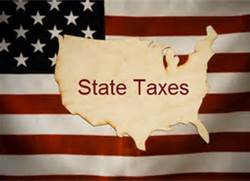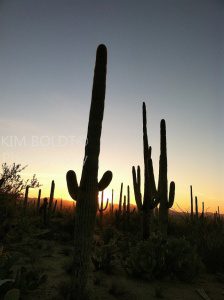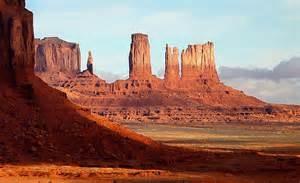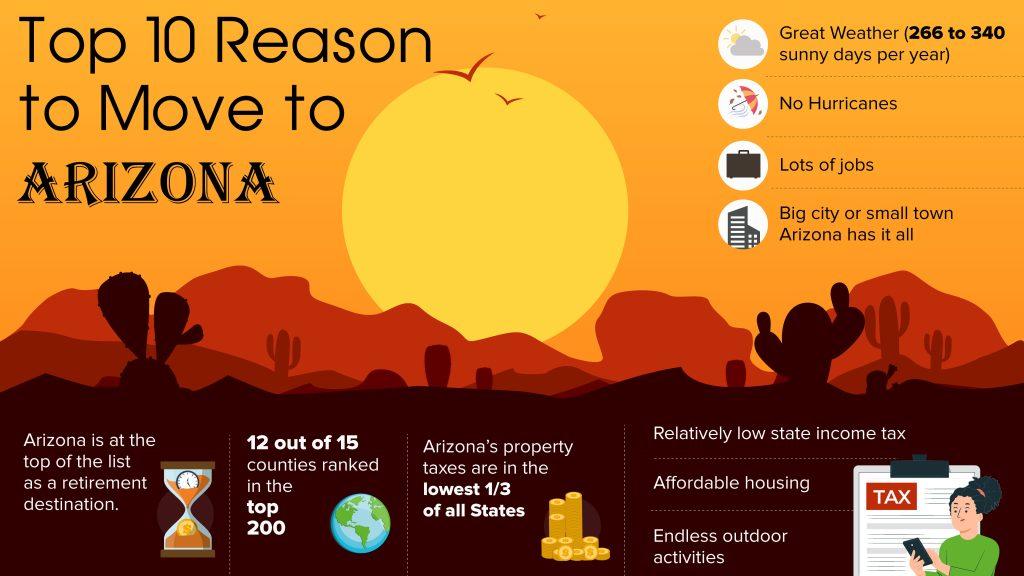Will Moving to Arizona Make You a Better Person?
Who Knows? But Arizona Has Great Weather, No Hurricanes and Lots to Do!
Moving to Arizona is at the top of the list as a retirement destination. But Arizona is more than a place for retirees.
Whether you live in New York or L.A., you have to consider Arizona as a top state to live.
Its teed up, so ask the question – Why?
Let’s start with the top 10 reasons why moving to Arizona is a great choice!
Here Are More Reasons To Consider Arizona?
Simple! Affordable housing, great weather, – OK, we already mentioned weather – good jobs and endless outdoor activities.
Arizona has great opportunities to purse jobs, schools and careers.
Not Ready For Retirement? No Problem!
Consider this. Arizona has good jobs available throughout the state. Want a city lifestyle? Arizona has jobs in the bigger cities.
Feel rural living is for you. Arizona has jobs there as well.
That means you could live almost anywhere in the state. And Arizona housing isn’t expensive at all.
Yes, there are pros and cons about moving to Arizona. As there are with any other state.
If Arizona is on your list as a place to live, consider out thoughts on Arizona and the place we call home – Tucson, AZ.
Lots Of Lifestyle Choices
Moving to Arizona means you can choose a lifestyle and climate that suits you. From a major city such as Phoenix to smaller towns such as Oro Valley, AZ. Or Winslow, AZ.
Oro Valley, AZ is a vibrant town of 50,000 residents. Founded in 1974, Oro Valley as grown and prospered. The community has may amenities for residents. Parks, golf courses, aquatic park, health care, restaurants and shopping.
See Oro Valley – Take a quick tour of Oro Valley
Winslow is a community of 9,600 people 58 miles east of Flagstaff, AZ. Once a thriving community on US Route 66. Today, it is a small rustic town made notable in the Eagles hit “Take It Easy”.
Moving To Arizona Puts You In One Of Best Places In The U.S.

The Post reviewed a study by the USDA Economic Research Service published on August 14, 2015. That study ranked 3,111 counties in the continental United States from best to worst.
Out of the 3,111 counties studied, the top 10 counties are in California. And Ventura County CA ranked number 1.
But that was before the massive fires in that area in 2017. And most of the California counties identified are on or near the San Andreas fault line. Something to ponder??
The State of Arizona has 15 counties. And 12 of the 15 ranked in the top 200 counties identified as the best places to live in the US.
So if it isn’t already there, put Arizona on our list of the best places to live in the US.
Answering the question “where should I retire, Arizona OR Florida?”
These two states come to most people’s minds when thinking about a place to retire too. Both have lots of sunshine and good weather.
But which is better?
As with most big decisions, it depends.
Your current lifestyle and where you live now play a big part in the decision-making process. But for most, the three big factors are – Weather, activities and home value!
Both Florida and Arizona have been top retirement destinations for decades. But it might surprise you to learn that living in Arizona may have more of what you want.
Ok, you I know you are thinking “how could that be?” We will get to the answer in a moment, but first a bit more about Arizona.
A Few Things To Know Before Moving To Arizona
Now this is important! Arizona Is A BIG Place.
Arizona is the 6th largest area in the United States. And seasonal temperatures are different based on where you live. Some people suggest Arizona is the hottest state in the US during the summer. Guess what? Their wrong!
In fact, the altitude in northern Arizona is higher than Denver.
> In The Northern Area of Arizona
For example, Flagstaff, in northern Arizona, is at 7,000 feet above sea level. It has big seasonal temperature changes.
Summer days are 70’s and 80’s. Evening temperatures will fall into the 50’s.
But winters are cold and snowy. Actually, loads of snow. 82 inches a year. Over 3 time the 26 inches of the average US city. Flagstaff holds an annual winter festival – Winterfest. Winterfest is Flagstaff’s 28-day winter extravaganza during February.
The good news is there are 266 sunny days per year in Flagstaff, Arizona. Sunny and cold in winter. Oh, and windy most of the time.
> In Southern Arizona
In Southern Arizona the weather is milder in winter and warmer in summer.
It is important to realize, Tucson, the second largest city in Arizona and is in southern Arizona. Some believe Phoenix is as well, but it’s not. Phoenix is in central Arizona.
Tucson has over 340 days of sunshine. Summers are warm. Ok, some people will say hot.
The average monthly high temperature for June to August is 98 degrees. Lows for the same period are 74 degrees.
But the only snow you will see is on the Santa Catalina Mountains. Mt. Lemmon is at 9,200 feet and the southernmost ski area in the United States.
In Tucson, you can ski on Saturday and play golf on Sunday.
With lots of Arizona attractions, day trips from Tucson are a great way to explore this great state. So pack a lunch, get a map and head out on one of the Arizona highways to see our state.
Let Me Walk You Through Some Arizona History
Arizona was the last territory to become a state. That happened in 1928. But without the Gadsden Purchase of 1853, Arizona might still be part of Mexico.
The Gadsden Purchase is one of the more interesting real estate deals made by the United States. Its sole purpose was to enlarge the borders of the southwest United States. Why you might ask.
The Gadsden Purchase expanded the southern boundaries of Arizona and New Mexico. Flat open land made building the trans-continental railroad cheaper and faster.
The Southern Railroad was key to settling the southwest. The discovery of silver and gold brought hordes of people to southern Arizona. On the railroad of course.
The Arizona territory become one of the leading producers of silver, copper and gold. Mining made Bisbee, AZ the first capital of Arizona.
And the gun fight at the OK Coral in Tombstone AZ in 1881 sparked the legend of Wyatt Earp.
The Gadsden Purchase And NCAA Basketball
Here is an interesting thought. Without the Gadsden Purchase, Southern Arizona and Tucson might be part of Mexico.
In that case, it is unlikely the University of Arizona would exist. And stay with me now, Kentucky may have won the 1997 NCAA tournament against????.
Comparing Arizona Cities
Moving to Arizona has something for everyone. Many people want warm winter days and lots of sunshine. That usually means they are snowbirds.
Others want to be able to play golf, swim, play tennis or hike any time they choose throughout the year.
For retirees, a top consideration is cost of living. For year around residents’ jobs and careers are at the top of the list.
The problem is how can you decide where to live in Arizona? The answer? Compare Arizona cities on your list and discover which one will be best for you!
And you can do that here – Compare Arizona Cities!
Moving to Arizona Brings Up The Question – What About Taxes?

Here is what we discovered.
Arizona has a state income taxes. But they are low relative to other states.
Arizona’s Tax Climate is in the “low burden” group of states. Yes, some states in the group don’t have an income tax or don’t tax wages. But there may be other things to consider.
Arizona’s state-tax rate tops out at 4.54 percent. This is the second-lowest rate among states with different tax brackets.
And Arizona’s property taxes are in the lowest 1/3 of all States.
The average property tax rate in Pima County is .81% of Assessed Value. Tucson, AZ is in Pima County.
So overall, taxes aren’t a “big cost” on residents of Arizona. Yes, you have to pay them, but think of them as “sun taxes”.
Things To Do In Arizona

But there are lots of things to do in Arizona.
One of the great things about Moving to Arizona are the National and State Parks.
Visiting Arizona’s canyons, craters, ancient ruins and enduring legends are interesting “day” trips. Pack a lunch, top of the gas and share a great experience with the whole family.
The most well-known is Grand Canyon National Park. It is not only a state treasure, its world renowned.
Other canyons on our planet are longer and wider (Australia’s Capertee Valley is both). Some deeper (Kali Gandaki Gorge in Nepal), but none more famous then the Grand Canyon.
The epic visual scale of the Grand Canyon is stunning. And its intricate layering, maze-like side canyons and vivid colors are stunning.
The Grand Canyon is 277 miles long. At its widest point it is 18 miles wide. And over a mile deep. Its winding path cuts down through more than two billion years of geologic time. And with some of the oldest rocks on earth at the bottom.
Don’t Stop Reading Now – There are a lot more Arizona attractions. Here are a few great Arizona places to visit.
Saguaro National Park – East and West

There are two areas within the Saguaro National Park, one on the East and West outskirts of Tucson.
Despite being a symbol for Arizona, Saguaros are only found in a small slice of southern Arizona.
These sentinels of the Sonoran Desert grow up to 60 feet tall. And arms appear on a Saguaro when they reach 65 to 70 years old.
The saguaro is one of many plants in Arizona protected by the Native Plant Protection Act. It’s illegal in Arizona to move a saguaro cactus off of private or public property without a permit.
And the bloom of the saguaro is Arizona’s state flower.
Petrified Forest National Park
When dinosaurs roamed the earth, eastern Arizona was a humid, subtropical rain forest. Hard to believe, but true.
How do we know?
Petrified trees in the park are evidence of the arid desert’s greener past.
Petrified Forest National Park covers 230 square miles. And named for its large deposits of petrified wood.
The Park is in northeastern Arizona, about 50 miles from the New Mexico border on Interstate 40. There is no public transportation to or within the park.
But wait, there’s more.
Monument Valley and Meteor Crater

It has long been a dramatic backdrop for Hollywood westerns. But even the biggest movie screens don’t do justice. It is an incredible landscape in north-east Arizona.
Monument Valley has hundreds of free-standing sandstone buttes and monoliths. They tower above the sweeping sagebrush landscape of the valley floor like monuments. Which is how Monument Valley got its name.
Another place of interest is Meteor Crater national natural landmark. It is a giant scare left by a meteor 50,000 years ago. A time when Woolly mammoths and giant ground sloths roamed eastern Arizona back then.
The meteor was the size of three school buses. Its impact into the earth had a force greater than 10 mega-tonnes of TNT. The impact left a massive circular hole in the earth’s crust near Winslow, AZ.
Arizona State Parks
When it comes to epic beauty and dramatic diversity, no state compares to Arizona. Our trails are your key to unlocking that treasure chest of scenic wonders.
Arizona has 17 state parks operated through the Arizona State Parks government agency.
Find more information here – Go Arizona State Parks
The Answer To A BIG Question About Moving to Arizona
For some, not having natural disasters is key in choosing a place to live. And between Arizona and Florida, Arizona wins by a landslide. NO pun intended.
Unlike Florida and southeastern coastal states, Arizona does not experience hurricanes or tornadoes.
This means that flood insurance is common for Florida homeowners. Not Arizona. But there are areas of Arizona where flood insurance may be necessary.
And there is a low probability of earthquakes. In contrast to California and west coast states. earthquakes have a low probability of occurring in Arizona. Very low.
A study in June 2018 by Bloomberg News indicated home values in high-risk area for natural disasters have declined over the 2007 to 2017 period. Or increased less than low risk areas.
Not only is Arizona a great place to live, but natural disaster also shouldn’t not be a drag on home values.
But There Have Been Fires
As for wildfires, they do happen. Summer heat and low humidity help to create wildfires. Dry brush and trees are fuel for a fire when lightning or human carelessness occurs.
A well-publicized wildfire was the Yarnell Hill Fire was a near Yarnell, Arizona. It started with a lightning strike on June 28, 2013.
It overran and killed 19 City of Prescott firefighters. Members of the Granite Mountain Hotshots.
It was the deadliest wildfire in Arizona, ever. Third worst in the U.S.
There were two worse fires in California. One near Oakland in 1991 killed 25. And in 2017, the Northern California fire killed 40.
But most Arizona wildfires are in rural and remote areas. In larger metro areas, wildfires are unlikely.
What do Arizona and Hawaii have in common?
Neither Arizona or Hawaii changes time in the spring and fall.
For decades, the phrase “spring ahead, fall back” has reminded people to change their clocks. But Arizona and Hawaii don’t.
Daylight Saving Time began in 1918 during World War I, to save fuel. But in 1919, Maricopa County (Phoenix) refused to accept the change. It observed a different time than the rest of the state.
After years of no daylight-saving in the country, became law during World War II. After the war, it went away. But reinstated in 1966.
Arizona observed daylight saving time for one year. After that, Arizona lawmakers decided to opt out of the law.
The reason?
The longer the sun was up in the evening the more energy households would use during the summers. So, Arizona opted out of Daylight-Saving Time to lower energy costs.
But a few places in Arizona do change time. The Navajo Nation in Northeast Arizona does observe MDT during daylight-saving months.
But the Hopi Nation – surrounded by the Navajo Nation – doesn’t observe Daylight Saving Time.
So in Arizona some “spring ahead” and “some fall” back. But most don’t.
Conclusion
If you are dreaming of living in southern Arizona or on the fence about moving to Arizona, here are 12 reasons to make Arizona your future home.
Thank you for visiting www.premiertucsonhomes.com! It’s one of the top real estate websites in Tucson. Our clients tell us that.
Our website provides information on communities and neighborhoods in the greater Tucson area. Want more? Give us a call – 520-940-4541.
We are ready to answer your questions and help you get the information you are looking for.
We are a top Realtor team in Tucson, AZ since 2002. Take a few minutes to read our profiles and client testimonials.
Are we the Tucson Realtors you have been looking for?
Sign UP to receive daily HOME TRACKER UPDATES - OR - Our Monthly NEWSLETTER. And get regular updates on the Real Estate Market and events in Tucson, AZ.
Questions about the Tucson Real Estate Market or Tucson Homes for Sale? Call Us - 520 940 4541 OR complete the - CONTACT FORM - and we will get right back to you!
BACk to ABOUT ARIZONA page.

